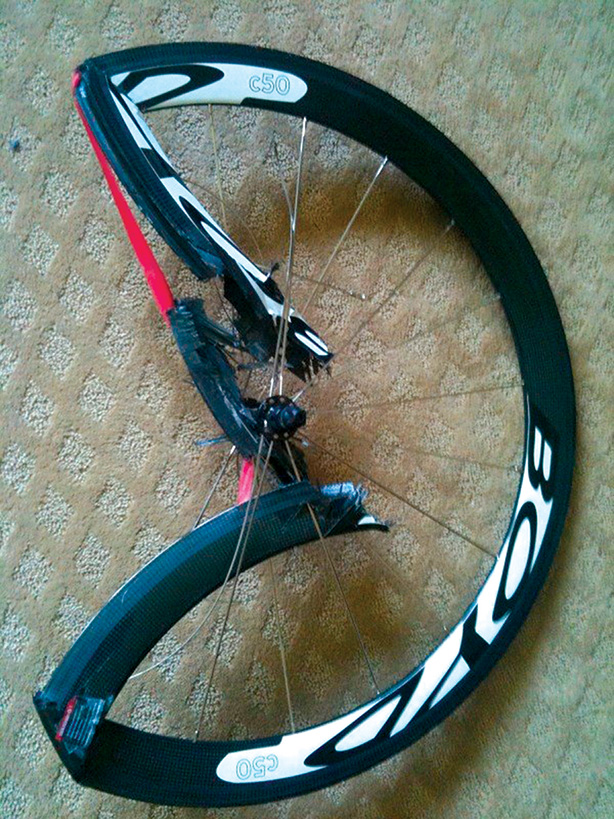Ensuring Bicyclers Are Safe to Race
Carbon composites and up-to-date regulations are supporting future bicycle designs
Previous Article Next Article
From JEC Composites Magazine
Ensuring Bicyclers Are Safe to Race
Carbon composites and up-to-date regulations are supporting future bicycle designs
Previous Article Next Article
From JEC Composites Magazine
Ensuring Bicyclers Are Safe to Race
Carbon composites and up-to-date regulations are supporting future bicycle designs
Previous Article Next Article
From JEC Composites Magazine

Mark Barfield, UCI

A traditional steel bicycle (left), compared with a “full carbon” road bike.

A traditional steel bicycle (left), compared with a “full carbon” road bike.

A damaged carbon composite wheel.
As an introduction to Cyclitech, the first international conference on bicycle technology (co-organized by JEC Group and the Society of Plastics Engineers and taking place December 8-9, 2015, in Brussels, Belgium), JEC Composites Magazine approached Mark Barfield, technical manager at the UCI (Union Cycliste Internationale), to ask him a few questions about composite materials and regulations. The UCI (www.uci.ch) is the official partner of the conference.
JEC Composites Magazine: Can you remind us what are the main technical regulations that restrict the design of a racing bike?
Mark Barfield: The UCI has a set of technical regulations that are in place to ensure that the bicycle is something recognizable as such and that it is powered in a way that we all understand.
The aim is to ensure that cycle sport remains accessible throughout the world and that the key component to a performance remains the rider. With these aims, and in support of the Lugano Charter, we have a set of regulations that cover most aspects of the bicycle. This starts with a very basic definition: “The bicycle is a vehicle with two wheels of equal diameter. The front wheel shall be steerable; the rear wheel shall be driven through a system comprising pedals and a chain.”
This sets out something very basic as a principle at the beginning of our regulations. The key regulations that follow relate to the design of wheels and frames. The wheel regulations have primarily been based on safety for some time now, initially with a destruction test that was designed to ensure that when wheels became damaged in crashes, they did not do so in a way that increased the level of risk to riders. This test is about to be replaced with a test based on a fixed force hitting the wheel and the ability of the wheel to sustain this impact without breaking. This is based on real-life scenarios that teams and manufacturers report on a regular basis.
We have worked very hard with the sport and the industry to arrive at this test, and it is a good example of where a governing body has listened to its industry and positively responded. It also enables us to pursue an international standard for a bicycle component. This is our clear direction of travel in relation to wheel and frame design and standards.
For bicycle frames, we currently have an approval system that regulates frame design but is not safety-related. The rules that cover frame design run to quite a number of pages of our rules and regulations book and define the double-triangle frame of the bicycle that we are familiar with. The rules are also written to allow some design innovation that carbon and other materials have facilitated over tubes of steel and aluminum, which were the main materials of bicycle design for many years. Again, the aim is to ensure the bicycle remains recognizable as such by the general public.
We are slowly reviewing these rules and hope to allow some small relaxations in a number of areas shortly. This, again, is driven by the industry, and the UCI is open to innovation whilst recognizing that we have a role as custodian of the sport. We are committed to working with the sport and industry as partners to bring those rules up to a position that maintains our position, while allowing the industry some additional flexibility.
It is anticipated that we will re-launch our frame regulations and guidance and seek to include an element of safety within our new regulations, as well as maintaining some element of design control. We will also be seeking international standards in this area and will be doing this with the aim of replacing our outdated weight limit for the bicycle (6.8 kg).
JCM: Are there specific rules that apply to composite materials in this field?
Barfield: There are no regulations governing the materials that can be used in the design or manufacture of bicycles, and we regularly see innovation in this area.
JCM: In your opinion, is innovation restricted by regulations nowadays?
Barfield: To a certain extent, innovation needs to be controlled to maintain the bicycle as a recognizable tool. We also understand that some of our regulations need to be reviewed as they do present a certain element of restriction that is probably no longer necessary. We feel that, by working with the industry, we can reach a point where we have a set of regulations that govern the bicycle both in terms of design and safety. Our aim is to ensure bicycles are safe to race and that they remain something we can all relate to, and we also want to encourage innovation to ensure that the industry behind cycling is healthy and buoyant.
JCM: Generally speaking, what kind of problems do you have with composite materials today?
Barfield: The issues that I observe are not related to our regulations, and are largely anecdotal. These issues are primarily about a product that does not meet the needs of the consumer and is of inferior quality to items we see in competition use. We are aware of the industry around counterfeit components and frames for bicycles. This is a concern for us and manufacturers as it damages brands and, more importantly, is often dangerous. This does seem to be an increasing problem for the cycling industry.
JCM: Do you believe composite materials could further increase the performance of athletes?
Barfield: The performance of the cyclist can undoubtedly be more efficiently harnessed by good equipment. That is equipment that allows effective power transfer, is comfortable in the environment, and is safe. Power transfer is highly important, and the developments in this area over the past twenty years have been very interesting. The materials used today in bicycle wheel and frame designs are much more sophisticated than those used in the past, but the aim is the same; that is to transfer the power a rider produces into speed as effectively as possible. The role that comfort plays in this, especially for road riders, cannot be underestimated.
This interview was also scheduled to be published in this month’s JEC Composites Magazine, and was used here with permission. For more information about Cyclitech 2015, go to www.4spe.org/Events or www.jeccomposites.com/events/composites-agenda/cyclitech.
